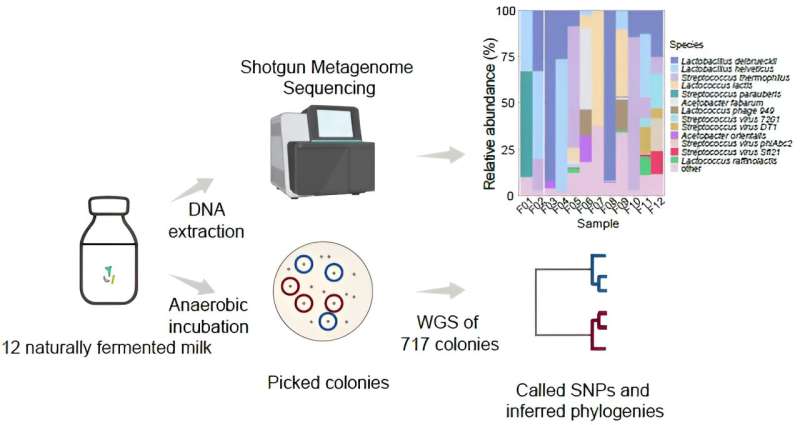This article has been reviewed according to Science X's editorial process and policies. Editors have highlighted the following attributes while ensuring the content's credibility:
fact-checked
trusted source
proofread
Intraspecific microdiversity and ecological drivers of lactic acid bacteria in naturally fermented milk ecosystem

Traditional fermented milks are produced by the inoculating technique, which selects well-adapted microorganisms that have been passed on through generations. Few reports have used naturally fermented milks as model ecosystems to investigate the mechanism of formation of intra-species microbial diversity.
In a new study, researchers led by Prof. Heping Zhang and Wenjun Liu at the Inner Mongolia Agricultural University, China, isolated and whole-genome-sequenced a total of 717 lactic acid bacterial isolates obtained from 12 independent naturally fermented milks collect from 12 regions across five countries. The research is published in the journal Science Bulletin.
The researchers further analyzed the within-sample intra-species phylogenies of 214 Lactobacillus helveticus isolates, 97 Lactococcus lactis subsp. lactis isolates, and 325 Lactobacillus delbrueckii subsp. bulgaricus isolates. The team observed a high degree of intra-species genomic and functional gene diversity within-/between-sample(s). Single nucleotide polymorphism-based phylogenetic reconstruction revealed great within-sample intra-species heterogeneity, evolving from multiple lineages.
Further phylogenetic reconstruction (presence-absence gene profile) revealed within-sample inter-clade functional diversity (based on carbohydrate-active enzyme- and peptidase-encoding genes) in all three investigated species/subspecies.
By identifying and mapping clade-specific genes of intra-sample clades of the three species/subspecies to the respective fermented milk metagenome, the team found extensive potential inter-/intra-species horizontal gene transfer events.
The microbial composition of the samples is closely linked to the nucleotide diversity of the respective species/subspecies. Overall, the team's results contribute to the conservation of lactic acid bacteria resources, providing ecological insights into the microbial ecosystem of naturally fermented dairy products.
More information: Lijun You et al, Intraspecific microdiversity and ecological drivers of lactic acid bacteria in naturally fermented milk ecosystem, Science Bulletin (2023). DOI: 10.1016/j.scib.2023.09.001
Provided by Science China Press





















